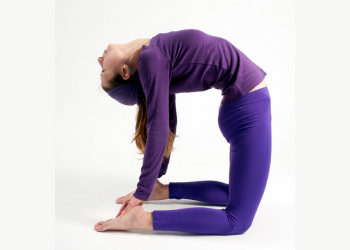Did you know Camel is also called a “ship of the desert?” Yes! The survival instinct in the most challenging conditions makes a camel an inspiration for a yoga asana. Since this pose’s resemblance is similar to a camel, this yoga pose is often referred to as Ustrasana or Camel pose. Let us go through this article to know more about Ustrasana, how to perform this pose, and all the benefits it offers. What is Ustrasana? The word Ustra means Camel, and Asana means pose, which is a meaning derived from Sanskrit. Ustrasana is a backbend pose that stretches the entire front of the body, boosting your core strength and the flexibility of your shoulders. According to your flexibility, you can bring variation in the deepness of this posture. Some people can touch their feet with their head while bending if they are advanced practitioners. Benefits of Ustrasana: We all know the positive effects yoga has on our bodies. Here is the list of benefits Ustrasana gives you: Performing the camel pose regularly helps maintain your digestive health by stimulating the abdominal organs. Practicing this pose alleviates pain from your lower back, strengthening the back muscles. The deep stretch in this pose helps with the back-related issues improving your posture significantly. It helps deal with the cramps, bloating, mood swings associated with the menstrual cycle. The stretch stimulates the thighs, abdomen, and arms muscles, helping you shed the unwanted pounds efficiently. The camel pose helps stretch the hip flexors, maintaining the muscles’ health, giving you toned hips. Ustrasana provides therapeutic effects on health conditions such as diabetes, spondylitis, thyroid, bronchitis, voice disorders, etc. This yoga pose unlocks heart chakras that help lower blood pressure by enhancing blood circulation and stretches heart muscles. Practicing camel pose helps maintain healthy kidney functioning, which provides relief from urinary infections or disorders. Beginner’s guide for Ustrasana: If you are a beginner, keep the following things in mind before you start performing Ustrasana: In the camel pose, you may not be able to reach your feet without causing strain initially. You can take the help of a wooden block and place your hands if you still cannot get to your legs. If you are a beginner, make sure not to hold this pose for more than 20 seconds. The right time to perform this asana is either in the morning or evening on an empty stomach. Keeping your bowels empty is necessary before you practice any yoga asanas. Therefore maintain a gap of four to six hours after you had your meals. Steps to Do Ustrasana Yoga (Camel Pose): Here is the list of steps you need to follow while performing the Ustrsana or camel pose: Place a mat and kneel on all fours on the ground. Keep your hips stacked over your knees and place your body upright. Make sure your soles face the ceiling, knees, and shoulders are in the same line. Place your palms around your ribs, your elbows pointing out. The thumb needs to be towards the backside of the ribs and other fingers towards the front side. Bend your ribcage backward, taking the support of your hands. Slowly grasp your heels while maintaining the position of your chest. Place your hips over your knees by bringing them forward. Keep your neck in the neutral position so that it doesn’t strain your neck. Now, slowly bring your head forward and hands towards your hips, getting your body into a kneeling position. Make sure you support your lower back with your hands while keeping your abs firm. Precautions for Ustrasana: Although yoga is quite beneficial, all asanas may not suit everybody. Depending upon your body’s flexibility and health conditions, you will have to take some precautionary measures. They are: It is better to avoid the camel pose if you have any neck or back injury. You can practice other asanas that will not put pressure on your neck or back. Avoid practicing Ustrasana if you have spondylitis, high or low blood pressure. If you have undergone surgery for an abdominal hernia, make sure you are entirely healed before you practice camel pose. The camel pose may trigger migraines.

How to Perform Ustrasana And Its Benefits.